This article needs additional citations for verification .(February 2024) |
Panj Free Economic Zone is a free economic zone in Khatlon Province in Tajikistan. [1]
This article needs additional citations for verification .(February 2024) |
Panj Free Economic Zone is a free economic zone in Khatlon Province in Tajikistan. [1]

The economy of Tajikistan is dependent upon agriculture and services. Since independence, Tajikistan has gradually followed the path of transition economy, reforming its economic policies. With foreign revenue precariously dependent upon exports of cotton and aluminium, the economy is highly vulnerable to external shocks. Tajikistan's economy also incorporates a massive black market, primarily focused on the drug trade with Afghanistan. Heroin trafficking in Tajikistan is estimated to be equivalent to 30-50% of national GDP as of 2012.
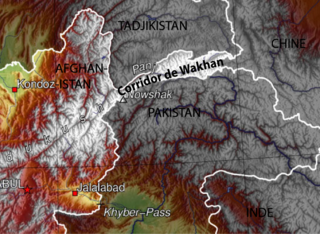
The Wakhan Corridor is a narrow strip of territory located within the Badakhshan province of Afghanistan. This corridor stretches eastward, connecting Afghanistan to Xinjiang, China. It also separates the Gorno-Badakhshan Autonomous Region of Tajikistan in the north from northern Pakistan in the south. This high mountain valley serves as the source of both the Panj and Pamir rivers, which converge to form the larger Amu River. For countless centuries, a vital trade route has traversed this valley, facilitating the movement of travelers to and from East, South, and Central Asia.
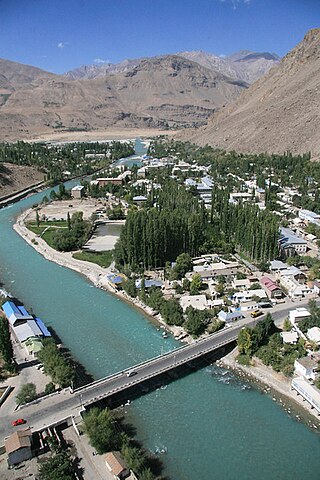
Khorog is the capital of Gorno-Badakhshan, Tajikistan. It is also the capital of the Shughnon District of Gorno-Badakhshan. It has a population of 30,500.
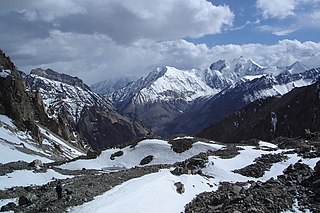
The Pamir Mountains are a mountain range between Central Asia and Pakistan. It is located at a junction with other notable mountains, namely the Tian Shan, Karakoram, Kunlun, Hindu Kush and the Himalaya mountain ranges. They are among the world's highest mountains.

Khatlon Region, one of the four provinces of Tajikistan, is the most populous of the four first level administrative regions. It is situated in the southwest of the country, between the Hisor (Gissar) Range in the north and the river Panj in the south and borders on Afghanistan in the southeast and on Uzbekistan in the west. During Soviet times, Khatlon was divided into Kurgan-Tyube (Qurghonteppa) Oblast – with the Kofarnihon and Vakhsh river valleys – and Kulob Oblast – with the Kyzylsu and Yakhsu river valleys. The two regions were merged in November 1992 into today's Khatlon Region. The capital city is Bokhtar, formerly known as Qurghonteppa and Kurgan-Tyube.
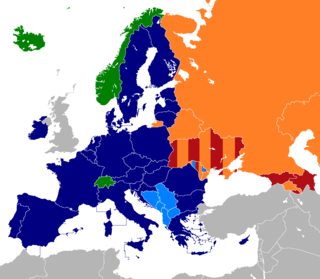
At present, there are six multi-lateral free trade areas in Europe, and one former free trade area in recent history. Note that there are also a number of bilateral free trade agreements between states and between trade blocks; and that some states participate in more than one free trade area.

Sughd Province is one of the four administrative divisions and one of the three provinces that make up Tajikistan. Centered in the historical Sogdiana, it is located in the northwest of the country, with an area of some 25,400 square kilometers and a population of 2,707,300, up from 2,233,550 according to the 2010 census and 1,871,979 in 2000. The capital is Khujand. The Province's ethnic composition in 2010 was 84% Tajik, 14.8% Uzbek, 0.6% Kyrgyz, 0.4% Russian and 0.1% Tatar.

Panj District is a district in Khatlon Region, Tajikistan. Its capital is Panj. The population of the district is 119,700. The district has been an area of ethnic tensions betweek its Uzbek and Tajik residents. During the early Soviet period the district was officially named Kirovobod District.

Vanj District or Nahiya-e Vanj is a district in eastern Tajikistan, in the north-west of the Gorno-Badakhshan Autonomous Region, with administrative capital Vanj.

Ishkoshim District or Nohiya-i Ishkoshim is a district in eastern Tajikistan, in the extreme south-west of the Gorno-Badakhshan Autonomous Region (GBAO). It borders Afghanistan along the river Panj to the south and to the west. The population of Ishkoshim district is 32,900.

Darqad District is a district of Takhar Province, Afghanistan. The district has 34 villages. Darqad did not change between the 325 and 398 district sets. Near the end of 2018, the district was considered to be Taliban-influenced, as opposed to the Afghan government. The district was Taliban-controlled by August 2021.

Hamadoni District is a district in the south-east of Khatlon Region of Tajikistan, located south of Kulob and stretching along a section of the Panj on the border with Afghanistan. Between 1950 and 2004 it was called Moskovskiy town, then renamed in honor of Mir Sayyid Ali Hamadani, a 14th-century Persia Great Islamic preacher, traveller, poet, and scholar who preached Islam in different parts of world, and is buried in Khatlon.

Commonwealth of Independent States Free Trade Area (CISFTA) is a free-trade area among Russia, Ukraine, Belarus, Uzbekistan, Moldova, Armenia, Kyrgyzstan, Kazakhstan and Tajikistan. Five CISFTA participants, all except Ukraine, Uzbekistan, Moldova and Tajikistan, are members of the Eurasian Economic Union, comprising a single economic market, although Uzbekistan and Moldova are observers.
Panj is a city in Tajikistan. Panj may also refer to:

Visitors to Tajikistan must obtain a visa unless they are citizens of one of the visa-exempt countries, or citizens who may obtain a visa on arrival, or citizens eligible for an e-Visa.
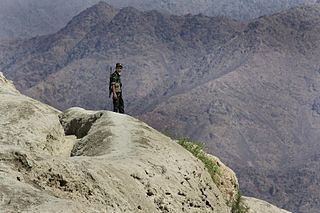
The Border Troops, also called the Border Service, is the border guard of Tajikistan. Functioning under the State Committee for National Security as part of the Armed Forces, the border guards are trained by the Organization for Security and Co-operation in Europe, along with the Afghan Border Police. A higher education college is located in the capital, Dushanbe, the Border Troops Academy, and a Border Troops Training Centre is located south of it, in the Rudaki District. The main control station of the border troops is the Border Management Center of the Main Border Guard Directorate of the SCNS.
Danghara, is a town in the Khatlon Region of Tajikistan. It is the capital of Danghara District. It is the hometown of Tajikistan's president, Emomali Rahmon as well as the country's first deputy prime minister, Asadullo Ghulomov, and several other senior government officials and members of parliament. As of 2020, the town's population was estimated at 31,100.
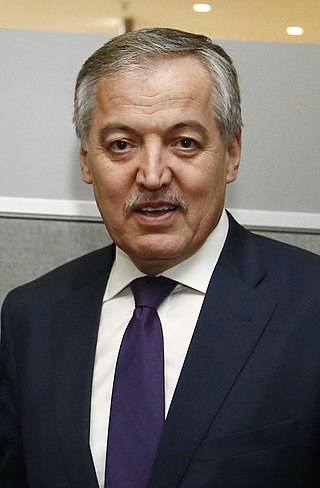
The Ministry of Foreign Affairs of Tajikistan is a government ministry of Tajikistan. It is the central executive authority exercising state administration in the sphere of relations of the Republic of Tajikistan with foreign countries and international organizations. It carries out its activities in cooperation with other central executive bodies, local government bodies, legal entities. The Ministry of Foreign Affairs of the Republic of Tajikistan has the status of a legal entity, its own seal, stamps, and bank accounts. The current Minister is Sirojiddin Muhriddin.
The 2021 Tajikistan Cup was the 30th edition of the Tajikistan Cup, the knockout football tournament of Tajikistan, with the winner of the cup qualifying for the 2022 AFC Cup.